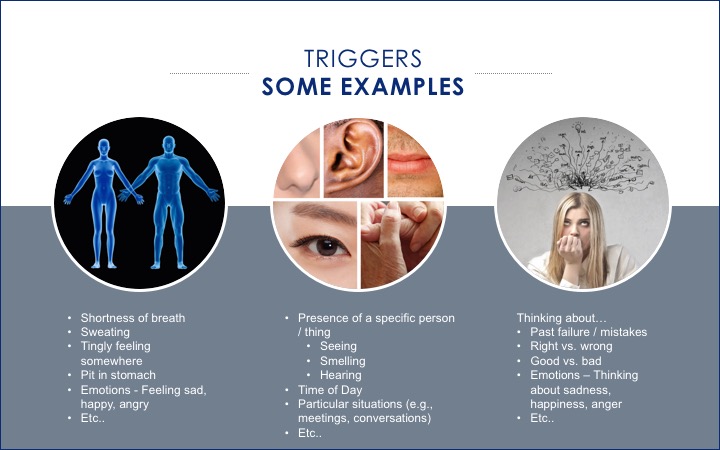We all have pet peeves. There are people or things that “push our buttons.” When our buttons are pushed we tend to become more stressed and agitated. More self-awareness of our triggers, and how they affect us, is important to reducing the corresponding stress.
Triggers Come in Many Forms
Let’s start by looking at some example triggers. I’ve divided them by how they show up: in our bodies, our worlds, and our minds.
Triggers can be felt sensations in your body. Maybe your palms get sweaty when you are nervous about saying something in a meeting. Maybe you get a pit in your stomach when you are presented with something that feels overly risky. It could be that you feel short of breath in certain situations. And some of you may feel your emotions in your body, which can sometimes be a trigger.
Triggers can be in your world, experienced directly via one or more of your five senses. One of the most common triggers is a specific person. You can be triggered by seeing them, hearing their voice, or even just reading their name. Some triggers are more situational. For example, maybe you’re triggered when you hear someone complaining.
Triggers can also be in your mind. You might be triggered by things you perceive as right or wrong, or good or bad. You might believe that an idea won’t work because you’ve tried to do something similar in the past and it didn’t work. When you have these thoughts, you may be triggered to dig in your heels and be less open-minded.
Identifying the Impact of Known Triggers
Let’s look at one of my known triggers to see how it may impact my behavior.
For example, I know that I am triggered by what I consider to be inconsiderate drivers. Drivers that dangerously weave in and out of freeway traffic without their turn signals. Drivers that tailgate. (You may be able to add to this list!)
In this case, I would ask myself, “how do these triggers impact me?” I might know the answer right off, or, if not, I’ll pay attention to myself to collect “data” the next few times I’m triggered behind the wheel. I might notice that I get really angry and yell out loud in my car. I might notice that I carry some of this anger/stress with me to my destination. I might notice that this impacts my mood for some period of time after I’ve gotten out of my car. Etc…
This provides grist for the internal mill. It’s a great time to ask myself challenging questions, such as “is it healthy for me to be taking on stress due to other people’s driving habits? Do I want my mood to be affected in this way and even impact my interactions with other people?” If the answer to one or both of those questions is “no,” I can use my awareness of this trigger to identify counter-measures.
Here are some ideas I can try:
• Taking a deep breath and relaxing each time I’m triggered by another driver.
• Yelling inside my car to let out ..and let go of…the anger energy.
• Checking myself when I arrive at my destination to ensure that I’ve let go of any associated stress or anger and that I’m not carrying that with me as I leave my car.
Identifying Triggers Corresponding to Known Self-Limiting Behaviors
Now let’s work in the opposite direction. When working on altering Self-Limiting Behaviors, it’s helpful to pay attention to identify any triggers that may be associated with the behavior you are trying to shift.
For example, if you are working on interrupting others less often, as you pay attention to your interruption pattern, you may learn that your interruptions are prefaced by (a) a feeling of frustration that the speaker is not getting to her/his point or (b) thinking that the only way for you to get your point across is to interrupt or (c, d, e…)
As you become more familiar with the trigger, this gives you the power to pre-empt your self-limiting behavior. For the example above, when you notice that you are frustrated that the speaker is not getting to her/his point, you can tell yourself something like “ok, this is usually how I feel just before I interrupt.”
Over time, you may then be able to move from just noticing your trigger to experimenting with behaving differently. Maybe your self-narrative changes to “there’s that frustration feeling. Let’s not interrupt this time. Let’s try to let go of this feeling of frustration and just hear the person out.”
Try This Out!
Think about your own life. Choose one thing that you know triggers you and spend some time self-observing and reflecting on how that impacts you and those around you. Start to experiment with tactics (e.g., take some deep breaths) that will help to diminish or eliminate any negative side-effects you experience from this trigger.
Remember, small shifts lead to big changes.
